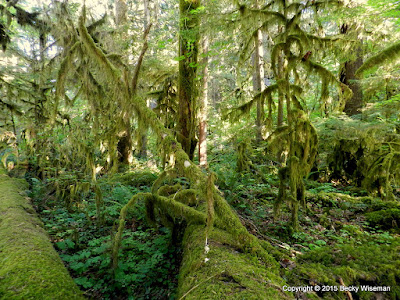After leaving Ape Cave I continued on up the road to Lava Canyon, my last major stop in the south side area of Mount St. Helens.
This sign, at the beginning of the Lava Canyon Trail, was almost enough to stop me from going but not quite. It warns of high cliffs near the trail along with smooth, slippery rocks. It states "The wisest decision you make here will be to stay on the trails and hike with great caution. Hikers have died in Lava Canyon because they went off-trail." Hmm. Okay. I proceeded. With extreme caution!
A description of the trail states "There are three sections of the Lava Canyon Trail distinguished by increasing difficulty. The upper trail is accessible and paved to a waterfall viewpoint. This portion is the easiest and leads you past a series of interpretive signs, which describe the formation of the canyon."
Looking down into the canyon from just beyond the end of the paved trail.
"Below the waterfall viewpoint the trail becomes more difficult; it is no longer paved and skirts high cliffs. This segment forms a loop, crossing the canyon on a 125-foot cable suspension bridge. The bridge provides spectacular views of the canyon below but may be unnerving to some hikers. The trail returns on the south side of the canyon, crossing a steel bridge upstream of the waterfalls and rejoins the paved trail." (The steel bridge can be seen in the photo above, just behind the lava rock.)
A little further down the trail, which was rather steep at this point and over slick rock with a bit of loose gravel thrown in for good measure. You actually lose sight of the river for awhile and then there was this...
The 125-foot cable suspension bridge. You can hear the river and see portions of it upstream but it is not really visible as you step onto the bridge. I was extremely happy that there was no one else nearby. It knew it would be quite bouncy with just me on it, I really didn't want anyone else crossing it at the same time.
With the camera draped around my neck and both hands on the side rails, I gingerly stepped onto the bridge. It swayed just a little with each step. Or was that just my imagination?
I tried not to look down but as I approached the middle of the bridge I couldn't help myself. I froze for a few seconds and couldn't move. The bridge was gently swaying in the breeze. Not much, but you could definitely feel it. All I could hear was the sound of the water beneath me and the rapid beating of my heart. Then common sense kicked in and I moved quickly off the bridge! Yes, I was shaking when I got to the other side. I sat for a few minutes, looking at the beauty around me and calming my nerves.
Then I went back out onto the bridge, oddly, feeling calm. I just had to get a couple of pictures!
Looking upsteam from (not quite) the middle of the bridge.
Looking down through the wooden slats.
A close-up view of a portion of the river, from the suspension bridge.
It was at this point that the lower trail, the most difficult, descends steeply into the canyon. You are warned "If you are uncomfortable with heights, this segment is not for you. Beginning at the suspension bridge, the trail crosses an exposed cliff face followed by a water crossing with a cable grab-line. A 30-foot metal ladder descends a vertical cliff providing access to the canyons deepest recesses and roaring waterfalls." Um, no. I'd had enough "excitement" for the day. They also recommended that you have a vehicle waiting at the bottom of the trail...
Back on solid ground once again, I continued on up the loop trail. A little more slick rock. More loose gravel. An uphill climb. Really not all that tough.
This view, from near the top, shows the river as it is about to drop over the edge.
The steel bridge. Crossing it was piece of cake after going over the suspension bridge!
The view from the middle of the steel bridge, looking toward the east.
The trail returned to the paved path and it was a short walk back up to the van. I was on the trail for about an hour and 15 minutes. It was so worth the effort! It was a beautiful day with magnificent scenery.
On the way back down to Forest Road 25, I made one more brief stop. Shown above is the area of the lahar from the 1980 eruption. A lahar is basically a river of mud and water with the consistency of concrete. When Mount St. Helens erupted on the north side the heat melted the snow and ice and sent a huge flow down the south side, carrying with it boulders and downed trees.
The website of
The Mount St. Helens Learning and Science Center is a wonderful resource with lots of photos and information on the eruption.
Another picture of Mount St. Helens from the south.
Published under a Creative Commons License.
Becky Wiseman, "Lava Canyon Trail - August 7th," Kinexxions, posted September 25, 2015 (http://kinexxions.blogspot.com/2015/09/lava-canyon-trail-august-7th.html : accessed [access date])























































